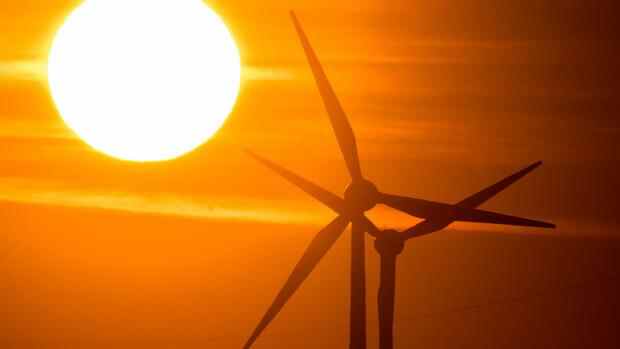Electricity generation from renewable energies fell by seven percent, mainly due to poor wind conditions.
(Photo: dpa)
Berlin While the federal government wants to launch a new relief package due to the high energy prices, the emissions data for 2021 again show the high dependence on oil, gas and coal in Germany.
Around 762 million tonnes of greenhouse gases were released in Germany in 2021, 33 million tonnes or 4.5 percent more than in 2020. Emissions increased in the energy sector in particular – by 27 million tonnes.
The transport and building sectors also exceed the annual emission levels specified in the Federal Climate Protection Act. This is the result of current calculations by the Federal Environment Agency (UBA), which UBA President Dirk Messner and Patrick Graichen, State Secretary in the Federal Ministry of Economics, presented on Tuesday.
Below is an overview of the individual sectors:
Top jobs of the day
Find the best jobs now and
be notified by email.
Energy: Declining power generation from renewable energies
Emissions in the energy sector were 247 million tonnes of CO2 in 2021, up 12.4 percent compared to 2020. Electricity generation from renewable energies fell by 7 percent, mainly due to poor wind conditions.
Because electricity consumption increased, electricity generation from hard coal and lignite increased. The use of lower-emission natural gas fell in the second half of the year due to the significant rise in gas prices.
Traffic: Less car traffic than before the corona pandemic
In the transport sector, CO2 emissions rose to around 148 million tons. This is not only an increase of 1.2 percent compared to 2020. The permissible annual emissions of 145 million tons were also exceeded. Since 2020, the Federal Climate Protection Act has prescribed continuously decreasing annual emissions for the individual sectors.
Car traffic is lower than before the corona pandemic.
(Photo: imago images/photothek)
The UBA cites road freight transport on motorways as one reason for the higher emissions in the transport sector. Car traffic, on the other hand, is lower than before the corona pandemic.
Industry: Increased use of fossil fuels
In industry, emissions increased by a good nine million tons of CO2 (plus 5.5 percent) to 181 million tons. They were almost back to the level of 2019, but just below the annual emissions of 182 million tons stipulated in the Federal Climate Protection Act.
The UBA cites catching-up economic effects as a result of the corona crisis and increased use of fossil fuels as reasons for the increase.
Buildings: Less heating oil purchases
Like the transport sector, the building sector also exceeds its annual emission level according to the Climate Protection Act, which is 113 million tons of CO2. 115 million tons were released, down from four million.
>> Read more about the topic:
The UBA explains this essentially with significantly reduced heating oil purchases. Due to the low prices and in anticipation of the CO2 price introduced in 2021, the heating oil stocks were extensively stocked up beforehand. Natural gas consumption, on the other hand, rose due to the weather. In 2020, the sector again exceeded the permitted annual emissions.
Agriculture: decline in animal husbandry
Emissions from agriculture fell by a good 1.2 million tons to 61 million and thus remained below the maximum permitted level of 68 million tons. According to the UBA, the number of animals continues to decline. The number of cattle fell by 2.3 percent and that of pigs by 9.2 percent. As a result, there was less liquid manure and emissions also fell.
Waste: Ban on landfilling of organic waste
Emissions fell by around 4.3 percent to a good eight million tons, nine would have been allowed. According to the UBA, the trend was essentially determined by falling emissions as a result of the ban on landfilling organic waste.
Emissions in Germany have fallen by 38.7 percent since 1990. Within a month, the Expert Council for Climate Issues will evaluate the data presented. The Federal Building and Transport Ministries then have three months to present an immediate program with which the two sectors are to be brought on course. By 2030, Germany wants to reduce its emissions by 65 percent compared to 1990, and be climate neutral by 2045.
Messner demanded on Tuesday: “We have to build more solar and wind turbines quickly.” Buildings have to be converted to heat pumps, and “we have to stop installing oil and gas heating systems as soon as possible”.
According to Messner, each and every individual can do something that also helps the climate: “Heat a little less, leave the car at home more often or, if it is necessary, drive more slowly.”
More: Tax cuts, fuel discounts and energy bills – the traffic light discusses these reliefs.

